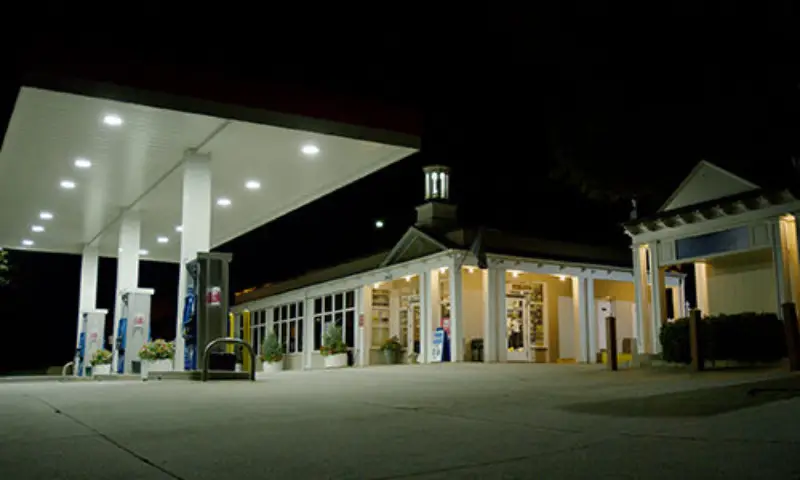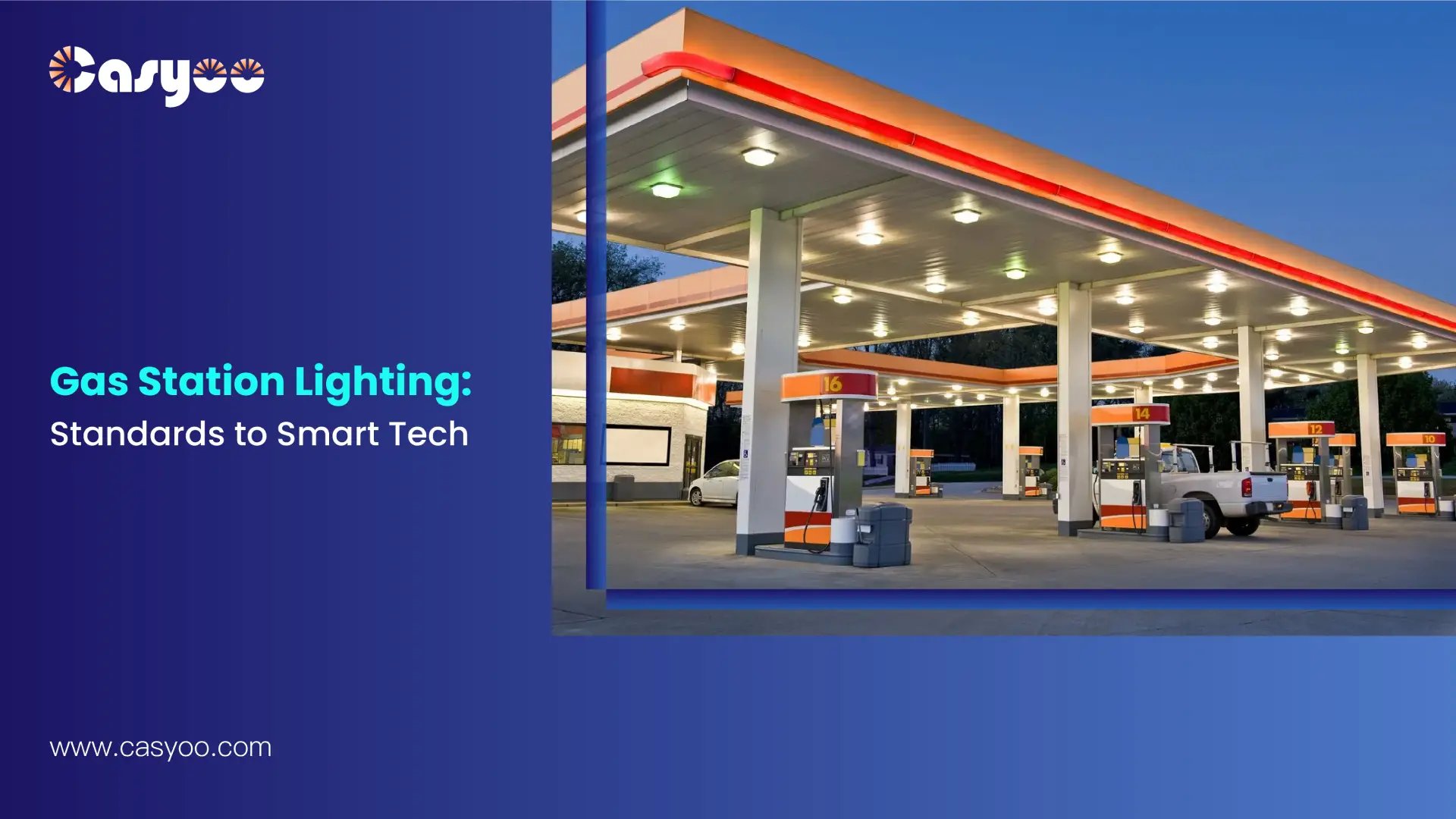Have you ever pondered why some gas stations appear to light like beacons in the night, while others fade into darkness? As a lighting expert with more than a decade of experience with LED technology, I’ve witnessed personally how adequate lighting can convert a gas station from a simple filling stop to a safe refuge for evening motorists.
The Evolution of Gas Station Lighting
Gas station lighting has improved significantly since the dull fluorescent tubes of the 1970s. Today’s modern gas stations face unique obstacles that their forefathers never envisioned. With 24/7 operations becoming the norm and safety concerns at an all-time high, maintaining flawless illumination has never been more important.
The importance of appropriate lighting goes far beyond simple visibility. According to studies, well-lit gas stations can increase nighttime customer traffic by up to 30% when compared to poorly lit competitors. This isn’t just about brightness; it’s about making customers feel comfortable and welcome.
The Science Behind Bright Lights
Imagine your gas station’s illumination as a silent security guard. Just as a uniformed cop deters criminal behavior, good lighting is a great deterrent to potential criminals. But why do petrol stations require such intense illumination?
Safety First: The Primary Driver
The most important reason is safety. Clear visibility is not only convenient, but also necessary when dealing with volatile liquids such as gasoline. A gas station, like a surgeon’s operating room, requires precise, shadowless lighting to prevent mishaps and assure accurate refills.
The Psychology of Light
Not only does uniform, bright lighting provide illumination, but it also conveys messages. According to industry studies, nearly 75% of first-time consumers rely their decision to stop at a gas station on its appearance from the road. Drivers, like moths, are drawn to well-lit environments that promise safety and cleanliness.
Lighting Solutions: Then and Now
The lighting sector has undergone a tremendous transition in the last decade. Traditional HID (High-Intensity Discharge) and fluorescent alternatives, which were once cutting-edge, now appear as obsolete as rotary phones in a smartphone age.
Traditional Lighting Options
HID lamps, particularly metal halide lights, have formed the backbone of gas station illumination for decades. They’re similar to the diesel engines of the lighting industry: powerful but inefficient. Fluorescent lights, on the other hand, are more efficient but suffer from temperature fluctuations and frequent switching.
The LED Revolution
LED technology has transformed gas station lighting in the same way that smartphones revolutionized communication. Modern LED systems can save up to 75% on electricity while lasting three to four times as long as traditional choices.
Essential Standards and Requirements
Gas station lighting standards differ by location, but they always have one common goal: to provide safety while remaining energy efficient. Let’s look at some fundamental requirements that influence lighting design.
Local and Regional Standards
Pump islands and canopy areas, as outlined in the SeaTac Municipal Code, require:
- Minimum horizontal illuminance: 1 footcandle at grade level
- Maximum illuminance: 5.5 footcandles
- Uniformity ratio: no greater than 4:1
- Maximum overall illumination: 22 footcandles

Installation Requirements
Most local codes require that canopy lights be recessed or flush-mounted in the canopy ceiling. Indirect lighting is frequently authorized as an alternative, provided that the fixtures are appropriately protected to send light only downward.
Safety Certifications
Regardless of location, gas station lighting must meet basic safety standards:
- IP65 rating minimum for weather resistance
- Explosion-proof certification for hazardous areas
- UL listing for electrical safety
Check local building codes and industry standards for specific requirements in your area. These criteria ensure optimum visibility while reducing light pollution and conserving energy.
Designing the Perfect Lighting System
Creating a good lighting design for a gas station is similar to composing a symphony; all elements must operate in perfect harmony. Understanding how light behaves at various heights and angles is critical for success. For ordinary canopy installations, we typically recommend beam angles ranging from 120 to 360 degrees, depending on mounting height and coverage requirements.
In cities, light pollution is becoming a bigger problem. Dimming the lights is not the answer; rather, a more calculated strategy is needed. Modern LED fixtures with fine optical control can offer adequate illumination while limiting light spill into adjacent regions.
Power and Height Considerations
In my experience, the relationship between mounting height and power requirements is straightforward: higher mounting positions demand more powerful fixtures. For a 6-meter canopy height, 100W LED bulbs typically provide adequate coverage. When the height is increased to 9 meters, 150W fixtures are required to provide adequate illumination levels.
Temperature and color rendering are critical factors in creating a welcome environment. To achieve correct color representation and a clean, alert ambiance, the majority of successful installations use cool white light (5000K-5700K) with a CRI greater than 80.
Zone-Specific Requirements
Different regions of a gas station require varied illumination, just as different rooms in your home serve different roles. The canopy area requires the most intense illumination, typically 20-25 footcandles, to assure safety during fueling operations.
According to IES regulations, pump islands necessitate careful lighting design. The recommended horizontal illuminance for regular operations is 12.5 footcandles, whereas 11-15 footcandles are required in high-security zones. This precise lighting level allows consumers to safely operate fuel dispensers and easily see displays while remaining energy efficient.
The IES rules set varying requirements for covered and unprotected areas. Uncovered parking areas require at least 1.5 footcandles, whereas covered parking areas require 5 footcandles to ensure appropriate visibility. These lower light levels, when compared to pump islands, nonetheless provide acceptable security while reducing light pollution and energy waste.
Smart Solutions for Modern Operations
LED lighting systems may do more than just enlighten. The lighting settings can be changed by modern control systems according to the activity level, weather, and time of day. Motion sensors can turn on lights as consumers arrive, then dim them to save energy during quiet hours.
These clever features directly result in cost savings in addition to being handy. Our projects have proven that intelligent control systems may reduce energy usage by 30-40% more than LED conversion alone.
The Economics of Better Lighting
Understanding the financial impact of lighting options necessitates looking beyond the initial price. Let us imagine a normal petrol station with 20 canopy fixtures.
Traditional metal halide installation could cost less initially, but consider:
- 3-4 times higher energy consumption
- Bulb replacement every 12-18 months
- Higher maintenance costs due to frequent servicing
- Shorter lifespan requiring complete fixture replacement sooner
The LED investment often pays for itself within 24-36 months due to lower energy and maintenance expenses. Following that, all savings will pass to your bottom line.
Looking Ahead: Gas Station Lighting’s Future
The lighting at petrol stations is already taking shape for the future. Remote control and monitoring are made possible by integration with IoT systems. Solar supplementation is becoming increasingly practical, especially for peripheral illumination requirements. Energy efficiency is improving, with newer LED systems pushing the limits of lumens per watt.
A Beacon in the Night
As dusk falls over the city, a contemporary gas station serves as a welcome beacon on the congested highway. Its canopy exudes a great blend of brightness and warmth, offering a welcoming sanctuary for tired travelers. A long-haul truck driver, after hours on the road, intuitively signals to turn in. For her, this is more than simply a filling station; it’s a refuge of safety and clarity in the darkness.
Customers go confidently beneath the canopy, where every number is sharp and legible, every corner is well-lit, and there is no shadow to be seen. The light spreads evenly across the forecourt, giving an aura of safety and comfort. This is exactly what we strive for with every lighting solution we design: to create environments that not only enlighten but also welcome.
Allow our team of specialists to assist you in transforming your gas station into an evening landmark that people know and want to visit. Contact us today to see how our comprehensive lighting solutions can help brighten your road to success.




